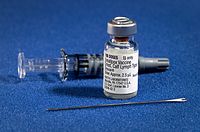
Photo from wikipedia
A number of studies have demonstrated the limited efficacy of S. pneumoniae type 3 capsular polysaccharide (CP) in the 13-valent pneumococcal conjugate vaccine against serotype 3 invasive pneumococcal diseases and… Click to show full abstract
A number of studies have demonstrated the limited efficacy of S. pneumoniae type 3 capsular polysaccharide (CP) in the 13-valent pneumococcal conjugate vaccine against serotype 3 invasive pneumococcal diseases and carriage. Synthetic oligosaccharides (OSs) may provide an alternative to CPs for development of novel conjugated pneumococcal vaccines and diagnostic test systems. A comparative immunological study of di–, tri–, and tetra–bovine serum albumin (BSA) conjugates was performed. All oligosaccharides conjugated with biotin and immobilized on streptavidin-coated plates stimulated production of IL-1α, IL-2, IL-4, IL-5, IL-10, IFNγ, IL-17A, and TNFα, but not IL-6 and GM-CSF in monocultured mice splenocytes. The tetrasaccharide–biotin conjugate stimulated the highest levels of IL-4, IL-5, IL-10, and IFNγ, which regulate expression of specific immunoglobulin isotypes. The tetra–BSA conjugate adjuvanted with aluminum hydroxide elicited high levels of IgM, IgG1, IgG2a, and IgG2b antibodies (Abs). Anti-CP-induced Abs could only be measured using the biotinylated tetrasaccharide. The tetrasaccharide ligand possessed the highest binding capacity for anti-OS and antibacterial IgG Abs in immune sera. Sera to the tetra–BSA conjugate promoted greater phagocytosis of bacteria by neutrophils and monocytes than the CRM197-CP-antisera. Sera of mice immunized with the tetra–BSA conjugate exhibited the highest titer of anti-CP IgG1 Abs compared with sera of mice inoculated with the same doses of di– and tri–BSA conjugates. Upon intraperitoneal challenge with lethal doses of S. pneumoniae type 3, the tri– and tetra–BSA conjugates protected mice more significantly than the di–BSA conjugate. Therefore, it may be concluded that the tetrasaccharide ligand is an optimal candidate for development of a semi-synthetic vaccine against S. pneumoniae type 3 and diagnostic test systems.
Journal Title: Frontiers in Immunology
Year Published: 2020
Link to full text (if available)
Share on Social Media: Sign Up to like & get
recommendations!